Jul 13, 2016
ASCO and the oncology community mourn the passing and honor the life of Alfred G. Knudson Jr., MD, PhD, who died on July 10. He was 93. Dr. Knudson was an internationally recognized geneticist and physician most known for his groundbreaking “two-hit” hypothesis of cancer causation, which “explained the relationship between the hereditary and non-hereditary forms of a cancer and predicted the existence of tumor-suppressor genes that can suppress cancer cell growth.”1
Dr. Knudson published this theory in 1971 as part of his more than 20 years of research into the genetic mechanisms that cause retinoblastoma. Dr. Knudson further theorized that genes existed in the cell—now known as tumor suppressor genes—that could function to stop abnormal cell growth. Although the medical community was originally skeptical of the “two-hit” hypothesis, Dr. Knudson is now credited as a visionary who helped establish a new era of research on tumor suppressor genes, including the 1986 discovery of RB1.2
“The entire oncology community is indebted to Dr. Knudson for helping us understand the role of oncogenes so that we could conduct more relevant translational research that has improved care,” said ASCO CEO Clifford A. Hudis, MD, FACP, FASCO.
Born in 1922, Dr. Knudson received his bachelor's degree from the California Institute of Technology in 1944, his medical degree from Columbia University in 1947, and his doctoral degree from the California Institute of Technology in 1956. He held a Guggenheim Fellowship from 1953 to 1954. Dr. Knudson was the dean of The University of Texas Graduate School of Biomedical Sciences at Houston from 1970 to 1976. He spent most of his career at Fox Chase Cancer Center (1976 to 2016), where he held several positions, including director of Fox Chase’s Institute for Cancer Research (1976 to 1982), Center President (1980 to 1982), and scientific director (1982 to 1983).3
““In my opinion, Al Knudson was the Mendel of cancer genetics. That is, he created the framework for how we understand the genetic roots of cancer,” said Jonathan Chernoff, MD, PhD, Chief Scientific Officer of Fox Chase Cancer Center. “Before Al’s formulation of the ‘two-hit’ theory of tumorigenesis, there was no satisfactory mechanism to explain the basis for inherited cancer syndromes. By examining the natural history of childhood retinoblastoma, which in inherited cases is often bilateral and occurs at a younger age than is sporadic cases, Al was able to infer that damage to two copies of a growth suppressing gene must be involved. That is, he postulated that ‘anti-oncogenes’ (today referred to as ‘tumor suppressor genes’) must sustain two hits for inactivation. Interestingly, it took nearly 15 years to confirm his theory, when technology for gene isolation became available, and mutations found in the retinoblastoma gene as he had predicted. Since his initial paper on the two-hit theory in 1971, dozens of tumor suppressors genes have been described, and patients with family histories of cancers are routinely screened for the presence of damaged tumor suppressor genes.”
Dr. Knudson received many prestigious medical awards for his contributions to science, including ASCO’s David A. Karnofsky Memorial Award and Lecture (1997), the Albert Lasker Award for Clinical Medical Research (1998), the Kyoto Prize for Basic Science (2004), the Bristol-Myers Squibb Freedom to Discover Award for Distinguished Achievement in Cancer Research (2005), and the AACR Lifetime Achievement Award (2005), among others.4
References
- Fox Chase Cancer Center. Knudson’s “Two-Hit” Theory of Cancer Causation. Accessed July 12, 2016.
- CancerProgress.Net. Oncology Luminaries: Dr. Alfred G. Knudson. Published May 19, 2014. Accessed July 12, 2016.
- Fox Chase Cancer Center. Fox Chase Conversations. Remembering Alfred G. Knudson. Published July 11, 2016. Accessed July 12, 2016.
- American Association for Cancer Research. Alfred G. Knudson Jr., MD, PhD, Class of 2013. Accessed July 12, 2016.

